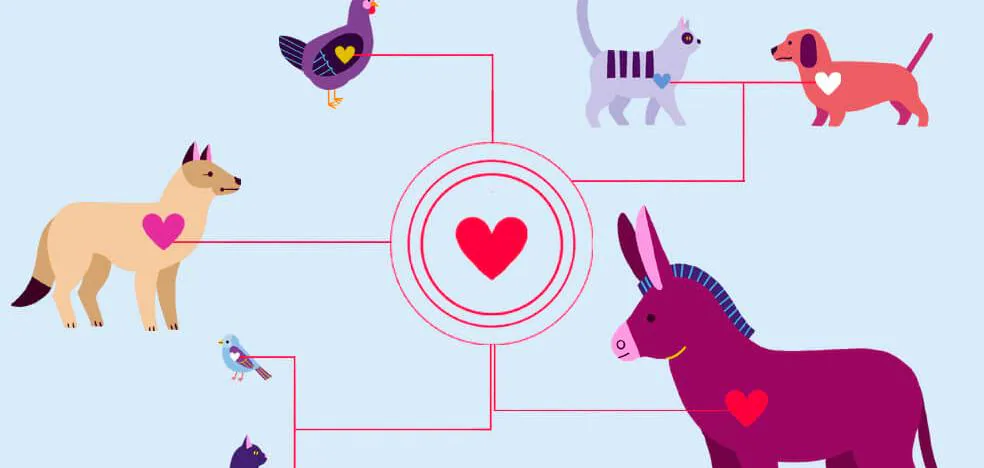Pancho was a 50-kilo giant schnauzer. He passed away long ago, but for years he was a blood donor. “He was so used to it that when it was his turn to donate, he put his foot down”, says who was its owner, the veterinarian Benito Pérez Delgado. The same can be done by many other companion animals, whose blood can save the lives of many of their namesakes, the problem is that, according to a study published in 2019, most owners are unaware of this possibility (70%).
To be eligible for donation, dogs must weigh more than 20 kilos, be between 1 and 8 years old and be in perfect health. These last two requirements are also extrapolated to the rest of the animals. «All species can donate blood but, at the veterinary level, we work with five, mainly: dogs, cats, rabbits, ferrets and horses », says Luis Viñals, director of the Madrid Veterinary Transfusion Center. Donations can be made once every four months.
Like humans, all of them – with the exception of ferrets, which do not have – have different blood groups. «In dogs, up to nine are known, with names like DEA, KAI –which means ‘dog’ in Korean and it was baptized that way because it was in this Asian country where it was discovered– or DAL –which comes from Dalmatian, as the first patient in the that was detected was of that breed– », says the specialist. “In cats there are three groups, A, B and AB, but although their name coincides with that of humans, we do not have the same receptor as them”, clarifies.
The big problem is that we can talk about many blood groups, but there is no analysis to determine which animal each has, because it is not economically profitable. “In Spain, in dogs we can only determine DEA-1, KAI-1 and KAI-2. The interesting thing is that dogs do not have maternally acquired canine antibodies against blood groups, which means that, in a first transfusion, they can receive blood from any group, ”says Viñals. Before a second transfusion, it would be essential to carry out an assessment to prevent adverse reactions, because by then the animal will have already created antibodies. This is not the case with cats, for example, which cannot receive different blood than their own type.
No ‘universal donor’
Donor extractions are used when a transfusion is necessary. This can occur due to certain infectious diseases (leishmania, parvovirus en cachorros), trauma (breaks due to a run over, for example), certain tumors, surgeries, internal or external bleeding, severe anemia and even poisoning. It should be noted that among animals there is no so-called ‘universal donor’, although until a few years ago it was thought that there was.
Given the lack of resources to carry out the necessary analyzes on the animals and find out their blood types, what is practiced to avoid post-transfusion reactions is an antigen-antibody cross-reaction test, that is, face the blood of the donor and the recipient. If they are compatible, there will be no reaction. This can be done easily in veterinary clinics.
Another curious aspect is that all the material that is used for donations is not prepared for veterinary medicine, since it is not of interest at an economic level, so that of human medicine is used. Thus, the donation bags are between 450-500 milliliters (ml) of blood. The downside is that most companion animals are not the size of a person, so in many cases these tools need to be adapted. “Maybe a 20-kilo dog can donate 500 ml of blood and fill a bag, but not a small breed. Cats donate a maximum of 50 ml, rabbits 40 ml and ferrets 10 ml. For its part, a horse can donate up to 8 liters ”, explains Viñals.
The first scientific research on a blood transfusion in animals was carried out with a dog in 1965, but it was not until 1988 that the first veterinary blood bank was created in the United States. In 2002 the model arrived in Spain, creating the Veterinary Transfusion Center directed by Viñals. “What we have created is a network of clinics throughout the country that have their permanent blood bank and we take care of nurturing it. There are also veterinary clinics that have their own donors, from whom they draw blood that they use when they have needs, ”explains the specialist.
The main difference between the blood bank itself and the transfusion center is that the latter, in addition to collecting and storing the extractions, is in charge of processing them, that is, separating the blood into its different blood components, distributing them and carrying out research work.
Donation systems
- Voluntary donation
-
You can go to a donation center with your pet and, if it meets the necessary requirements, you can donate. In countries like the United States there are even donation buses, like those of the Red Cross, but for animals. It is an altruistic act, but there is usually a detail, like giving a bag of feed.
- Donor colonies
-
These are farms prepared to house animals that are specifically used to make donations. There they live in optimal conditions, but without contact with the outside, in order to have an exhaustive sanitary control over them and that they do not contract diseases.
– .


